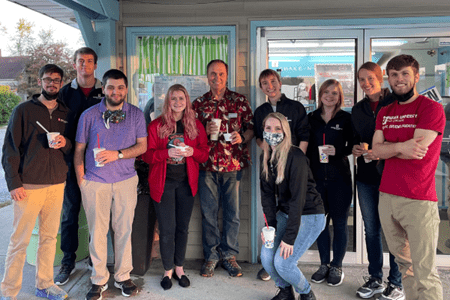Nearly a quarter of Indiana’s population live in rural parts of the state and face significant health disparities, due in part to a chronic physician shortage and less access to healthcare. This spring, first-year medical students on the IU School of Medicine-West Lafayette campus helped fill that gap. They traveled throughout the western swath of Indiana, volunteering to perform sports physicals for teenagers at 29 schools.
“It is incredibly important for students to learn to give back to their communities early in their training,” Gregory Loomis, MD, assistant professor of neurological surgery at IU School of Medicine-West Lafayette said. “Over the past year we have been so limited in our ability to interact during the pandemic. This is an ideal opportunity for students and their communities.”
Every spring, all student athletes in Indiana are required to receive a yearly physical to be eligible to play. The Indiana High School Athletic Association (IHSAA) suspended physicals last year due to the pandemic, and as a result, some student athletes had not seen a primary care physician for more than a year. Loomis alongside Craig Voll, PhD, ATC, manager of sports medicine at Franciscan Health for the western region of the state, spearheaded a partnership to match medical students with schools.
“In rural parts of the state, it can be difficult to access a primary care provider,” Voll said. “Due to COVID-19, we wanted to perform more thorough heart examinations because of the virus’s proven impact on the lungs and cardiovascular system.”
In fact, during his 25 years of overseeing sports physicals, Voll has identified at least three cases of hypertrophic cardiomyopathy. This is a potentially life-threatening condition in which the heart muscle becomes abnormally thick. It usually has no symptoms and serves as an important reminder why even at a young age it is so important to receive regular physicals.
Sports physicals allow doctors to identify if it is safe for an individual to start playing a sport. They include a medical history and physical examination that is more specifically focused on athletic issues. In addition to scanning for physical health, medical students also had the opportunity to talk with student athletes about mental health.
“My favorite part of the experience was getting to interact with teenagers and talk about their mental health concerns,” Siena Cooper, a rising second-year medical student, said. “I love to see the openness and commitment to mental well-being from this young generation.”
The partnership represents a win-win for students and the communities they served. During the pandemic, first-year medical students experienced a dramatically altered experience. Faculty administered virtual classes, and many opportunities were limited due to restrictions around in-person gatherings. After volunteering, the group sometimes stopped for ice cream, a seemingly simple bonding experience that was impossible just a few months ago.
“This was really an opportunity to end the year on a high note,” Loomis said. “I am so impressed by our medical students, and it was wonderful to see them interact with patients and gain first-hand experience about the responsibility we have toward our patients.”
Loomis and Voll already plan to expand next year, potentially growing the program to offer 1,000 physicals at schools across the region. They will also bring in sports medicine physicians to teach students about the unique aspects of a sports physical. These efforts will help many more teenagers in Indiana gain easier access to care before they hit the field.
In addition, designing the program so that medical students travel to schools works well for rural families who cannot easily take a day off of work drive to a primary care provider. The physicals are discounted or in some instances free, removing another critical barrier for families that may face financial concerns around access to healthcare.
“It’s important for us to start providing care in the community,” Cooper said. “It allows us to get out of our books and teaches us to communicate with patients directly.”
Interested in how IU School of Medicine provides care to Hoosiers? Leaders in Medical Student Education were awarded a $7 million dollar federal grant in 2020 to improve care for the underserved, including Hoosiers who live in rural areas. Programs developed from the grant will help the medical school provide stronger training to medical students and prepare them to serve communities around the state.
